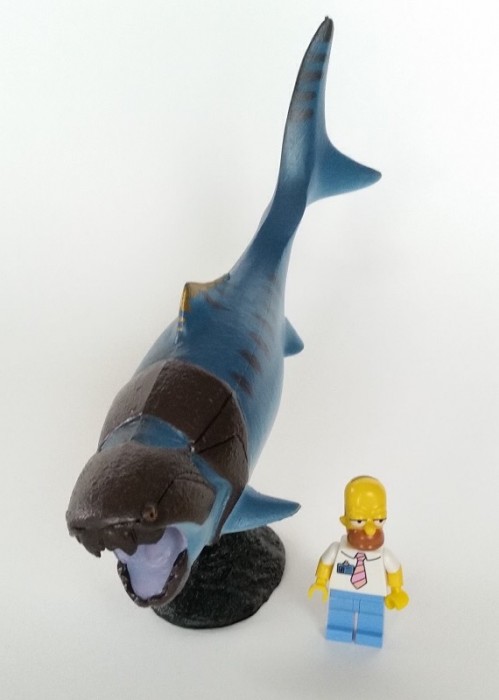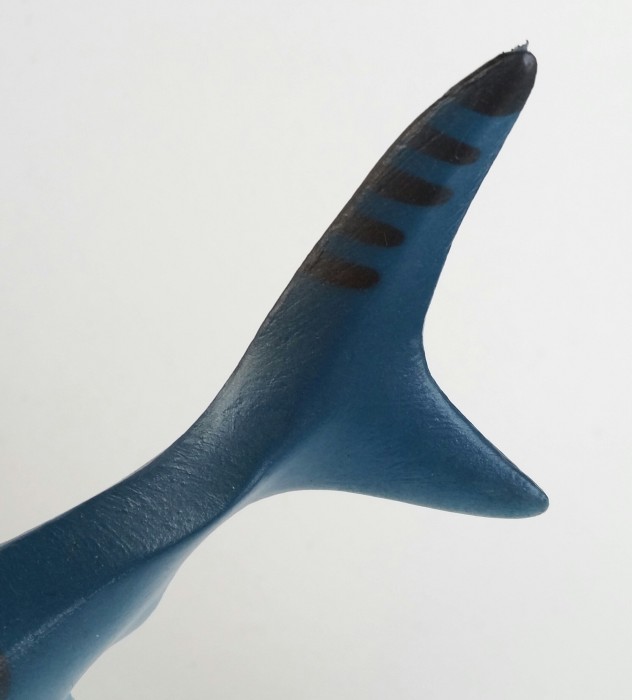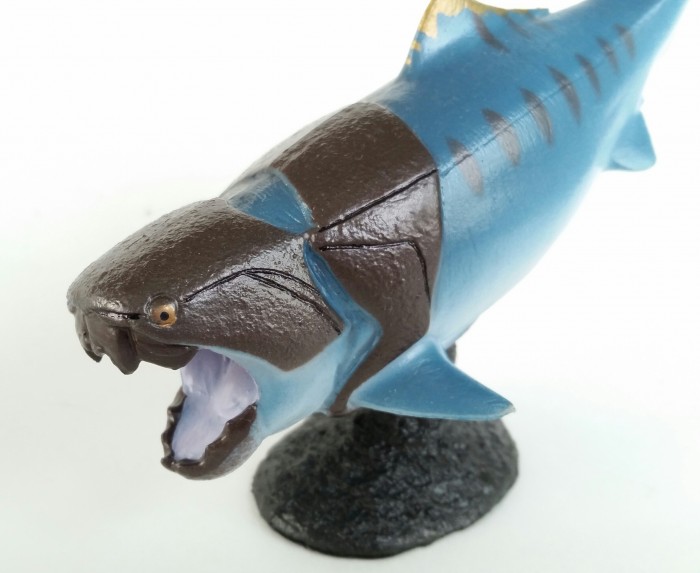Review and photographs by Tim Sosa
In the Devonian period, the largest animals were arthrodires, huge armored fish informally referred to as placoderms. ‘Arthrodire’ means “joint-necked,” referring to the fact that there was a hinge in their armor between the thorax and the back of the head. One of the largest arthrodires was Dunkleosteus, a fish so ancient that when Tyrannosaurus rex was walking around, Dunkleosteus had already been extinct for almost 300 million years! It’s also the prehistoric fish that toy companies have made most often. Today’s review concerns the version produced in 2014 by Favorite Co. Ltd. (formerly known as Kinto).

It’s a hefty toy, thick-bodied as you would expect a large marine predator to be; when you’re large, having a circular cross-section makes you much more hydrodynamic. Measured along the spine, it’s almost 20 cm long, which puts it at right about 1:40 scale for a big 8 meter individual (some estimates range up to 10 m for the largest specimens but it requires a lot of assumptions about proportions). A 10 or 12-year-old child would be about the height of the Lego minifigure in the picture below.

This toy reflects good research. The head is boxy and its armor plates are all arranged correctly. In life, it probably wouldn’t have been possible to see every suture, as some would have been covered in skin. But it looks much less skeletal than some toy versions of Dunkleosteus. Some other toys even show the sclerotic ring, a series of small bones that provide internal support for the eyeball–the Favorite rendition correctly hides the sclerotic ring inside the eyeball where it belongs. It’s painted a pleasing blue with gray highlights and armor plates, with a nice fishy pink inside the mouth. It comes with a well-balanced stand so you can display it in a dynamic swimming pose.

The tail might strike some as slightly controversial. I looked up technical descriptions of Dunkleosteus remains, and I couldn’t find any reference to tail fossils. All known remains are of the head armor, which fossilizes much more easily. I even asked a fish paleontologist, who confirmed that nobody knows what the back half looked like. Smaller relatives, like Coccosteus, have fossils that show a simple, eel-like tail. But Dunkleosteus was so much bigger that water would be thinner from its point of view. You can understand this by thinking about walking on water–you can’t do it, but many insects can. For a large fish, swishing an eel-like tail would make the whole body move side to side, which would both cause it to go-off course (“yaw”) and create turbulent spots that would slow it down. A small fish pushing against more viscous (thicker) water wouldn’t have the same problems. So it seems likely that a big predator like this would have had a crescent-shaped tail, like tunas and some kinds of sharks (my fish paleontologist friend shares this opinion).

This is an excellent Dunkleosteus replica, and although its retail price in Japan is $10 or less, in most parts of the world you’ll need to look for it on eBay or other secondary market sources, where it can be found for roughly twice the price.
Disclaimer: links to Ebay and Amazon on the DinoToyBlog are affiliate links, so we make a small commission if you use them. Thanks for supporting us!




I was definitely part of the crowd that was confused to see this figure released with a lobed tail after years of seeing eel-like depictions; but the logic for this design choice is sound, and the model is quite impressive in-hand. This is almost certainly one of the best Dunks on the market to date.
Here’s an update on the tail. The science is not settled but is clearly moving toward the shark-like interpretation. https://www.ncbi.nlm.nih.gov/pmc/articles/PMC5723140/
I want one for my desk.
You know, when I get a desk.
Good review of a good dunk. Good analysis on the tail design. You’re right, all that mass forward would mandate a strong tail, closer to a shark’s than an eel’s. – Matt Bille, FaceBook Dunkleosteus terrelli page
[…] Dunkleosteus is a big toy, about 24 centimeters long measured along the spine (the Safari Ltd and Favorite Co. Ltd versions are a bit smaller). Like other fish, Dunkleosteus didn’t have a single fixed adult […]
Thanks for the review! – Beautiful figure with a great price!
I learned something new about fish today!
Great review and very informative, just the way I like them! I’ll have to get this model.